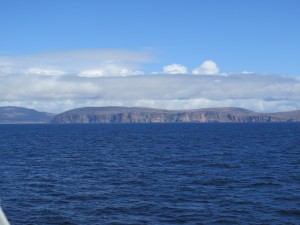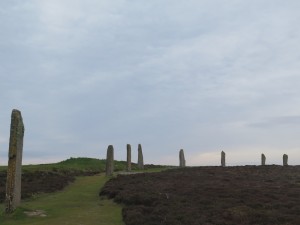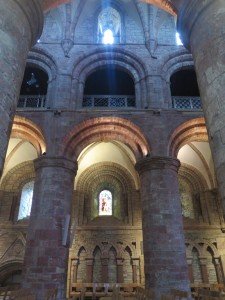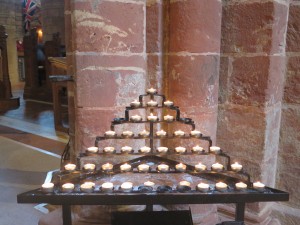 On Monday, we left the mainland of Scotland in our wake [always remembering, of course, that Scotland is not really a ‘mainland’, but part of an island] and turned our face toward Orkney, following the light north. We sailed through deep swells – and sunshine! Who would have guessed we would go north into warm(er) sunshine? – from Scrabster to Stromness, which puts us within 500 miles of the Arctic Circle. International travel nudges me to relocate myself in the greater scheme of things…reawakening me to the startling fact that Denver is on a latitude with Valencia (Spain) which puts most of our European travel well north of the place we call home.
On Monday, we left the mainland of Scotland in our wake [always remembering, of course, that Scotland is not really a ‘mainland’, but part of an island] and turned our face toward Orkney, following the light north. We sailed through deep swells – and sunshine! Who would have guessed we would go north into warm(er) sunshine? – from Scrabster to Stromness, which puts us within 500 miles of the Arctic Circle. International travel nudges me to relocate myself in the greater scheme of things…reawakening me to the startling fact that Denver is on a latitude with Valencia (Spain) which puts most of our European travel well north of the place we call home.
Kirkwall and Stromness, the two largest towns on Orkney, align with Juneau…so we are up there. Today, sunrise was at 4:01 a.m. and sunset will occur at 10:20 p.m. The sky never gets completely dark, only darker. So although the Orcadians do not see the sun over the horizon at midnight even on the solstice, they enjoy long, long daylight hours in the half of the year that falls on either side of June 21-22.
The people who have lived on these islands have always followed the path of the sun closely, a fact that is attested to by the monuments we came here to see. So, as I walk the Ring of Brodgar which (unlike Stonehenge or Avebury) has two crossing avenues designed to align with various sunrises and sunsets, as well as different phases of the moon across the year, I am pondering the light. As I stand in the perfectly square main chamber of Maeshowe, built so that the sun will illuminate the back wall of the chamber at sunset on the winter solstice, I am pondering the light.
 I am someone who is profoundly affected by lack of sunlight. Weather that is grey and overcast (or raining or snowing or sleeting) day after day drains my energy until getting out of bed and dressed becomes an almost insurmountable challenge. Standing in this summer light, I close my eyes and try to imagine the earth tilting and tilting and my days shortening and shortening toward December 21-22 when Orkney will see the sun rise at 9:06 a.m. and set at 3:16 p.m. Six hours! Just over six hours of sunlight! My energy begins to slip just thinking about it.
I am someone who is profoundly affected by lack of sunlight. Weather that is grey and overcast (or raining or snowing or sleeting) day after day drains my energy until getting out of bed and dressed becomes an almost insurmountable challenge. Standing in this summer light, I close my eyes and try to imagine the earth tilting and tilting and my days shortening and shortening toward December 21-22 when Orkney will see the sun rise at 9:06 a.m. and set at 3:16 p.m. Six hours! Just over six hours of sunlight! My energy begins to slip just thinking about it.
And I think of our language and our metaphor which elevate the light and denigrate the dark. I think of how universal is the moral, and religious, and psychological, and physical association of light with the positive, with goodness, with purity, with wisdom, with humor. How automatic is the reverse, as well: the association of dark with evil, with inferior, with lack of perception, with fear, with hatred. It’s crystal clear that our human instinct turns us toward the light whence comes all good things. Except…
…except spending so much time in Scotland this year and coming further north to Orkney even for a few days, I have had to take note of the folk who live year after year in places where there is a huge swing from longest day to shortest day; where long, hard months of darkness define half of every year. I cannot help but notice that steadily, across generations, those nations have a disproportionate impact on the world of thought, of science, of exploration, of invention, of medicine, of literature, of art. Nobel Laureates in many disciplines, are nominated and chosen all out of whack with the population.
My daughter reminds me occasionally that correlation is not causation, but I don’t think it hurts to ponder the obvious questions. What transformation of self do I fail to encourage and nurture, when I resist the darkness? What right brain wisdom remains veiled, hidden, locked in my unconscious? What dreams are not dreamed? What depth of soul goes unexplored because I don’t spend enough time in the slow, quiet darkness to embrace the mystery, the unknown, the unseen? What images lie – waiting – at the bottom of the creative sea, like unsalvaged treasure because I never dive deep enough to discover them?
Yes, Maeshowe, and Knowth, and Newgrange – and the circles of mound-tombs that dot the landscape around each of them – are places of death where the bones and ashes of ancestors were placed. But how many of our myths tell us that death is the threshold of energy that allows new birth, abundant re-creation? The tomb is a place of darkness, but so is the womb.
I am someone who seems to need more sunlight than these northern reaches would ever provide for me…but it is also worth noting that I am someone who (since early childhood) has needed longer hours of sleep than many of my peers. And during these weeks when I have permission to rest as much as I want, I am noticing that my dreams have been provocative and revealing. Along with much of the 21st C. westernized world, clicking along at warp speed for far too many hours each day, I am in a near-constant state of sleep-deprivation. [Perhaps this sounds familiar?] I suspect that I need to spend less time turning on lights as the day darkens, and more time allowing the natural pattern of light and darkness to dictate my rhythm. [Perhaps this also sounds familiar…]
I pray for the discipline to do this and see what happens. If you would like to join me in being more intentional about resting and dreaming — welcoming the healing darkness — here are some words to get us started.
 Wise Gaia, dancing your long measures
Wise Gaia, dancing your long measures
through light and shadow,
tilting and turning,
spun laughing from hand to hand
between moon and sun,
teach me – shaped from your very self:
water and soil and air –
to trace as gracefully
the pattern of the cosmos.
Atom by spinning atom,
reawaken in me the kinetic memory of perfect tempo,
intricately weaving ebb and flow,
pause and move, receive and release.
May it be so. Let it be so.
–Andrea
Text © 2015, Andrea La Sonde Anastos
Photos © 2015 Immram Chara, LLC
From the top, the photos are Orkney appearing on the horizon, the Ring of Brodgar, Candles in St Magnus Cathedral (Kirkwall), and the arches of St Magnus.
Reminder: Clicking on any photo will enlarge it.
